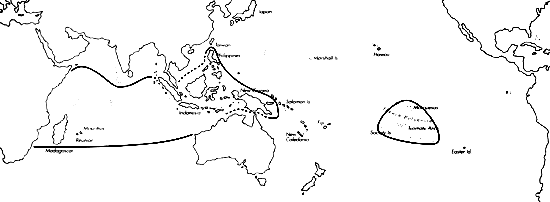Range: Indian Ocean (absent from Red Sea); Philippines to Papua New Guinea. French Polynesia. and Marshall Is.
Description: Moderately small to moderately large. light to moderately solid. Last whorl usually ovate or ventricosely conical, sometimes conical; narrowly ovate to narrowly conoid- cylindrical in French Polynesia (Pl. 50. Fig. 7): outline usually convex, left side sometimes constricted at base. Shoulder rounded to indistinct. Spire of moderate height, outline domed to almost straight. Larval shell multispiral. First 3-6 postnuclear whorls distinctly to weakly tuberculate. Teleoconch sutural ramps flat to convex, with 1-2 increasing to 7-10 very weak spiral grooves or striae. Last whorl with fine, closely spaced. usually finely granulose spiral ribs from base to shoulder.
| Shell Morphometry | ||
|---|---|---|
| L | 27-68 mm | |
| (-Fr. Polynesian form 27-34) | ||
| RW | 0.08-0.25 g/mm | |
| (L 31-56 mm; -Fr. Polynesian form 0.04-0.09 g/mm) | ||
| RD | 0.51-0.62 | |
| (-Fr. Polynesian form 0.47-0.49) | ||
| PMD | 0.72-0.86 | |
| (-Fr. Polynesian form 0.72-0.83) | ||
| RSH | 0.13-0.22 | |
Ground colour white to pale blue, tinged with violet in specimens from French Polynesia. Last whorl with 2 broad pale to dark brownish violet spiral bands, leaving 1 narrow ground-colour band below centre and sometimes 1 below shoulder. Base usually violet. Larval whorls and first postnuclear sutural ramps pinkish violet. Following sutural ramps with irregularly set brown radial streaks and blotches. Aperture violet, grading to white during growth.
Periostracum brown, moderately thick, slightly translucent to opaque, with interlaced axial ridges.
Dorsum of foot light red, darker at ends, with white and sometimes black dots. Sole of foot uniformly red or paler centrally, with sparse white dots. Rostrum light red, darker basally. Tentacles white to light red, darker at tips. Siphon red, ringed with dotted tan lines and sparsely dotted with white, sometimes paler distally or ventrally (Pl. 76, Fig. 55; Plate 83, Second row) (Chaberman, pers. comm., 1981; Pearson, unpubl. observ.).
Habitat and Habits: Shallow subtidal to about 25 m, from coral reef lagoon to fore-reef; on lagoon pinnacles, in caves and under coral rocks.
Discussion: C. glans is the most similar species; specimens are often difficult to distinguish. On the sutural ramps, C. glans has usually strong spiral grooves separated by granulose ribs rather than weak spiral grooves or striae as in C. tenuistriatus. C. glans also has a generally cylindrical last whorl (PMD 0.66-0.84) with stronger, somewhat less closely spaced spiral ribs. Other similar species are the sympatric C. granum and C. coffeae. C. granum differs in its bluish or reddish violet colour, and very weak spiral ribs on the last whorl; its pattern includes 3 (vs. 2) spiral colour bands and brown spots edging the subcentral ground-colour band adapically. For comparison with C. coffeae, see the Discussion of that species. Shells from French Polynesia (Pl. 50, Fig. 7) have a narrower last whorl and are tinged with violet instead of blue. We provisionally consider them to represent a geo-graphic race of C. tenuistriatus. Indian Ocean specimens (Pl. 50, Figs. 4,6) differ only slightly from those from the W. Pacific (Pl. 50, Fig. 5); the former have lighter and mere brown colouration and more conical last whorls. We include C. tendineus var. granulosus as a synonym of C. tenuistriatus rather than of C. violaceus, because its type locality, Annaa Id., Tuamotu Archipelago, is likely correct, as it was collected by Hugh Cuming (see Dance, 1986).

C. tenuistriatus range map
This section contains verbatim reproductions of the accounts of 316 species of Conus from the Indo-Pacific region, from Manual of the Living Conidae, by Röckel, Korn and Kohn (1995). They are reproduced with the kind permission of the present publisher, Conchbooks.
All plates and figures referred to in the text are also in Röckel, Korn & Kohn, 1995. Manual of the Living Conidae Vol. 1: Indo-Pacific Region.
The range maps have been modified so that each species account has it own map, rather than one map that showed the ranges of several species in the original work. This was necessary because each species account is on a separate page on the website and not confined to the order of accounts in the book.